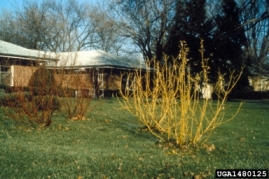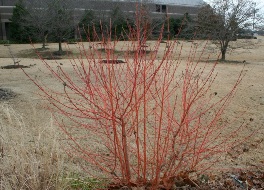In winter, the drab browns and whites of our landscapes become boring. One good way to fix that is to use plants in the landscape that have more color throughout the winter - this includes plants such as Redosier Dogwood.
Redosier Dogwood, Cornus sericea, also is called Red Twig Dogwood. This is a great shrub for year-round interest. It has deep green leaves that turn purplish to reddish in the fall. Redosier Dogwood flowers in late May to early June with flat-topped groups of white flowers. The fruit is a small white berry that appears in the fall and persists into the winter. This shrub grows up to 8 feet tall and wide and has smooth, red branches to provide interest in the winter months.
There are many varieties of Redosier Dogwood. 'Flaviramea' is commonly known as Yellow Twig Dogwood due to the yellow twigs instead of red. 'Cardinal' is a large shrub, 8-10 feet tall and wide, that has cherry red stems. For a smaller Red Twig Dogwood, one option is 'Kelseyi', which is only 24-30 inches tall and wide. 'Kelseyi' is not quite as red as the straight species. 'Isanti' is another smaller choice that grows up to 5-6 feet tall and wide and has bright red stems. As there are many more choices, you should be able to find the perfect Red or Yellow Twig Dogwood to suit your needs.
Redosier Dogwood is a fast growing shrub species. It can be cut back to the ground every 3-5 years to keep it healthy and to keep the red coloration bright. This plant will tolerate many different environmental conditions, including very wet conditions and shade. According to Michael A. Dirr in the 'Manual of Woody Landscape Plants,' "Redosier Dogwood does best in moist soil and is often observed in the wild in wet, swampy situations." Red Twig Dogwood can be planted as a specimen shrub, in a border planting, and as a bank cover to prevent soil erosion. The biggest problems that face this shrub include leaf spot and twig blight or canker.
Red Twig Dogwood is native to the northern portions of North America. The bark of Redosier Dogwood was used as a dye by Native Americans, according to North Carolina State University. The University of Alaska states that Redosier Dogwood bark was used by natives as a tea, twigs and stems were used as basket rims and salmon spreaders, and the berries were eaten.
Redosier Dogwood is a favorite shrub for many due to its wonderful winter color. The red becomes quite vibrant in the winter and gives us another color besides brown or white to look at during the drab winter months. The shrub grows fairly fast and in many different environmental locations so it will grow in most any area of your acreage. With so many different choices in size and color, it is easy to fit Redosier Dogwood into your landscape.



